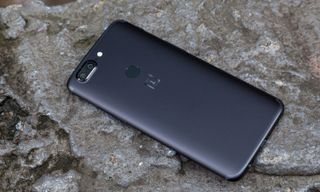OnePlus 5T Review: Say Hello to the Phone Bargain of the Year
OnePlus improves upon its previous flagship by throwing in a massive 18:9 display, shrinking the bezels, and tweaking the cameras to deliver one of the best phones of the year, all for $499.
Why you can trust Tom's Guide

As much as we loved the OnePlus 5 earlier this year, it couldn’t help looking a little dated compared to the likes of the LG G6 and Galaxy S8. When the rest of the industry decided to embrace full-screen 18:9 displays, OnePlus was selling a handset that looked behind the curve, even though it was state-of-the-art underneath.
What a difference five months can make. After mysteriously discontinuing sales of the short-lived OnePlus 5, the company has already moved on to its next act: the OnePlus 5T. It’s a device designed to address some of its predecessor’s most obvious sticking points, without compromising the “flagship for less” value proposition the OnePlus brand is known for.
Compromise this phone doesn’t. In the 5T, OnePlus has delivered a device every bit as polished, powerful, and premium as its fiercest rivals. The lone difference? You only have to spend hundreds less.
Updated May 21
We've updated our review of the OnePlus 5T based on our in-depth smartphone drop tests. See the results below. Note that OnePlus has since come out with a successor to the 5T, the OnePlus 6. Read our review of that new phone.
Price and Availability
(Editors' Note: Since this review was originally published, OnePlus has sold out its stock of OnePlus 5Ts in the U.S.; it's now selling the OnePlus 6.) Like the OnePlus 5, the 5T comes in two flavors: 64GB of storage with 6GB of RAM for $499, and 128GB and 8GB for $559. Fans will notice a slight price hike however, as OnePlus has increased both variants by $20 and $30 over the previous model, respectively. As of Jan. 9, OnePlus is adding a limited edition model, the OnePlus 5T Sandstone White, which costs $559 and comes with the same 128GB of storage and 8GB of RAM as the $559 Midnight Black 5T.
The 5T is only available unlocked from OnePlus, and exclusively supports GSM carriers such as AT&T, T-Mobile, Cricket, and MetroPCS. Networks operating on CDMA systems, like Verizon, Sprint, and Boost, will once again not be compatible with OnePlus’ latest flagship.
OnePlus 5T Specs
| Price | $499/$559 |
| OS | Android 7.1.1 Nougat with Oxygen OS |
| Screen Size (Resolution) | 6 inches (2160 x 1080) |
| CPU | Snapdragon 835 |
| RAM | 6GB/8GB |
| Storage | 64GB/128GB |
| microSD slot? | No |
| Rear Camera | Dual 16-MP (f/1.7) and 20-MP (f/1.7) |
| Front Camera | 16-MP (f/2.0) |
| Battery Life (Hrs:Mins) | 11:22 |
| Water Resistance | No |
| Size | 6.14 x 2.95 x 0.29 inches |
| Weight | 5.74 ounces |
| Colors | Midnight Black/Sandstone White |
Design: Finally full-screen
The “T” in 5T is OnePlus’ way of signaling refinement, and indeed the new phone’s look is an minor evolution that alleviates the OnePlus 5’s greatest design shortcoming: those chunky bezels. They’re nowhere to be found on the 5T, and it’s a much better phone for it.
As a result, the 5T has a bigger screen — 6 inches versus the previous model’s 5.5 — and a higher screen-to-body ratio, at 80 percent up from 73 percent. However, the 5T is practically the same size as the OnePlus 5, only a wee bit taller, so it’s no more challenging to hold.
Bezels are nowhere to be found on the 5T, and it’s a much better phone for it.
As with many full-screen flagships, the move to an 18:9 display has comes at the cost of the OnePlus 5’s front-facing fingerprint sensor. Rather than scrubbing it entirely, OnePlus merely shuffled the sensor over to the back, centered as on the Pixel 2, Essential Phone, and LG V30. It’s a compromise the company admits it didn’t want to make, and one that it has attempted to mitigate with the addition of a new Face Unlock feature. But more on that later.

Otherwise, the OnePlus 5’s hallmarks — its rounded aluminum frame, notifications side switch, and chamfered edge running along the perimeter — are all here again, making for a handsome handset that doesn’t necessarily push any design boundaries, but looks and feels as great to use as any flagship phone this year without “Galaxy” in the title.
One aspect we’re thrilled OnePlus chose to retain in the 5T is the headphone jack. OnePlus says it will continue to support 3.5-millimeter connectors until USB-C headphones are more widely available and reasonably priced, so let’s hope the streak continues for at least a couple more years.

Unfortunately, OnePlus hasn’t taken the opportunity of the 5T’s release to throw in stereo speakers or proper IP water resistance — two gaps in the device’s otherwise flagship-caliber spec sheet. That said, OnePlus promises the device is splash-resistant.
The new Sandstone White 5T gives OnePlus's phone a more distinctive look than the standard version. The sandstone finish adds a measure of grittiness to the back of the phone, which will take some getting used to for some users. In our hands-on time with the Sandstone White 5T, we grew to appreciate the finish, while also enjoying the chrome and red accents on that model.
Durability: Not that tough
We tested the OnePlus 5T’s toughness by dropping it on its face onto wood from a height of 4 feet and 6 feet; we then dropped it on its edge and face onto concrete from 4 feet; we then dropped it on its edge and face from 6 feet onto concrete.
No damage occured when the OnePlus 5T was dropped face-first onto wood from a height of 4 and 6 feet. A 4-foot drop on its edge onto concrete similarly did little to mar the phone, but a 4-foot face drop, followed by a 6-foot edge drop onto concrete. caused some pretty big cracks in the OnePlus 5T — including in front of its camera. A 6-foot face drop onto concrete finally caused the screen to stop working completely.
As a result, the OnePlus 5T earned a low toughness score of 4.3 out of 10. To see the results of other smartphones, as well as our complete scoring methodology, check out our smartphone drop tests.
Display: AMOLED for the masses
The OnePlus 5’s 1080p AMOLED display was practically faultless, and we’re pleased to report the narrative is the same for the 5T. The only difference is the larger size on the 5T, which only makes the content on-screen look more immersive, delicious, or whichever adjective you prefer.

The 5T is one of those phones, like the Galaxy Note 8 and iPhone X, that convinces you that you need an AMOLED panel in your next handset. While it’s not quite as sharp as some of its competitors — the Pixel 2 XL’s screen leads the way at 537 pixels per inch, while the OnePlus comes in at 402 — the 5T sports brilliant color, great visibility at an angle, and none of the splotchy, paper-like texture that you encounter on either the larger Pixel or the LG V30.
MORE: Best Big Screen Phones
The screen is really a sight to behold on the 5T. OnePlus has once again included some beautiful abstract wallpapers on this device, so even your otherwise ordinary home screen absolutely bursts off the display. But the 5T’s screen really earned its stripes as I watched the hilarious teaser trailer for Deadpool 2, which features the anti-hero doing his best Bob Ross impersonation in front of a stark black background. The AMOLED panel delivered perfect darkness; Deadpool may as well have been painting from within the endless void of space, so you could say the display really helped it nail the Bob Ross aesthetic. On the other side of the spectrum, the charming Peter Rabbit trailer was bright and cheerful with lush greens and exquisite detail.
Turning to the numbers, the OnePlus 5T’s default color mode — which opts for more saturated hues and cooler whites than the sRGB or DCI-P3 settings — recreated 218 percent of the sRGB gamut, which is on par with the OnePlus 5’s 220 percent. The 5T notched a Delta-E color accuracy rating of 0.47 (numbers closer to 0 are better) and peak full-screen brightness of 394 nits. That’s a fair bit shy of the 433-nit smartphone average, but consistent with most AMOLED screens, and just below the Note 8 at 408 nits.
The 5T also receives new technology OnePlus is calling Sunlight Display. Similar to Apple’s True Tone feature, Sunlight Display is designed to adjust contrast under harsh light to make content on-screen appear more visible in certain media apps. In my experience though, it never made a very perceptible difference.
Camera: Note 8-quality photos for $450 less
If it ain’t broke, don’t fix it. That’s the approach OnePlus has taken with the 5T’s dual rear cameras and 16-megapixel front facing shooter. Well, mostly — because while the 16-MP, f/1.7 aperture primary rear lens is unchanged, the secondary 20-MP camera is quite different.

Last time around, that second lens was a telephoto with a narrower field of view, and also employed a much smaller f/2.6 aperture. On the 5T however, this camera has the same focal length and wide aperture of the standard one. So what’s the difference?
It’s called Intelligent Pixel Technology, and OnePlus says it helps brighten dark scenes without creating noise by combining four pixels on the image sensor into one, to let in more light. Below we can see how it enhances a scene of a warmly-lit bar compared to the Galaxy Note 8.
Samsung’s $950 phablet totes some of the best dual cameras on the market today, but it surprisingly falters against OnePlus’ latest in a few key areas. The 5T’s rendition is simply brighter and more vibrant. There’s a richness to the light behind the shelves and a rainbow of hues in the liquor bottles that the Note 8 fails to pick up on. If you zoom in, the image from the OnePlus is even a little sharper, making for clearer text on the labels.
Moving outside, it’s a closer call; you have to look very carefully to see differences between the two exposures. The sky in the 5T’s shot is a brighter shade of blue with less noise than in the Note 8’s example. The OnePlus also provides a little more detail in the deep shadow between the two buildings in the bottom right. But once again, it’s the cheaper phone that somehow manages to pull out the sharper, all-around brighter scene.
When it came time to test out Portrait Mode with my colleague Cortney, though, we were presented with an interesting dilemma. As I said earlier, OnePlus nixed the telephoto lens for the 5T. As a result, you won’t find 2x optical zoom in the new model — a disappointing omission. But that also means you’ll have to approach portraits a little differently.
Samsung’s $950 phablet totes some of the best dual cameras on the market today, but it surprisingly falters against the OnePlus 5T latest in a few key areas.
Without a telephoto lens, I had to take a couple steps in just to frame the shot properly, and even then the end result looks strange for what is ostensibly supposed to be a portrait. The wide angle of the 5T’s second lens pulls in way more of the background than I’d like. The bokeh blur looks convincing enough, and in terms of color and sharpness, this comparison is a dead heat. Still, it was much easier to get the right portrait with Samsung’s Live Focus mode (whose bokeh effect you can adjust on the fly) and the zoom offered by the Note 8’s telephoto lens.
I headed back inside one last time for a stereotypical shot of a basket of fruit, where the Note 8 clawed back some points with a cleaner, more detailed representation. Personally, I prefer the OnePlus’ punchier colors, but there’s no denying that the 5T ventures well into oversaturation territory. The apples in the foreground are so deeply red that they’ve lost a bit of texture, and the text on the sticker appears significantly blurrier.
When comparing selfies, the Note 8’s front-facing camera came out particularly strong. Whereas the 5T opts for a reddish skin tone, Samsung’s phablet touts more realistic lighting and better contrast.
Battery: Strong, but not the best
The OnePlus 5T inherits the OnePlus 5’s 3,300mAh battery, which delivered more than 13 hours of longevity when we tested it earlier in the year. So how did the 5T compare with its larger screen? Favorably, though there’s some room for improvement.
OnePlus’ latest flagship lasted for 11 hours and 22 minutes in our battery test, which consisted of continuous web surfing on T-Mobile's LTE network. It’s not surprising to see overall battery life take a slight hit given the new display, even despite OnePlus’ battery optimizations in OxygenOS. This is a powerful phone, with a premium processor and 8GB of RAM, so 11-plus hours is pretty respectable. By comparison, the Note 8 called it quits at 11:04, while the Pixel 2 XL lasted 11:11.
In just 30 min connected to the pre-packaged wall adapter, our 5T reached 59 percent. After an hour, it was nearly full, at 93 percent.
One thing that hasn’t changed, however, is the quick charging speed afforded by Dash Charge technology, which comes courtesy of OnePlus’ parent company, Oppo. After just 30 minutes connected to the pre-packaged wall adapter, our 5T reached 59 percent. After an hour, it was nearly full, at 93 percent. That's good enough to pass for the fastest-charging smartphone on the market, according to our testing.
Another benefit to Dash Charge is that because it works by increasing current (the cable itself is slightly wider than a typical USB Type-C cable) rather than increasing voltage, it keeps the device cooler, which means charging speeds aren’t throttled even while the phone is running processor-intensive tasks.
Performance: Among the fastest Android phones
As the OnePlus 5 was already one of the most powerful Android phones on the market, this mid-cycle replacement didn’t really need to improve in the performance category. Indeed, the OnePlus 5T is just as snappy as its predecessor, with the same Qualcomm Snapdragon 835 processor and a generous 6GB of RAM, with an optional 8GB if you fork over another $50.
The Snapdragon 835 puts it level with 2017’s finest flagships, from the Pixel 2 to the HTC U11 and Galaxy S8. But the stock RAM allotment is currently equaled only by the Note 8 in the US market. Because of it, the 5T absolutely flies, particularly when multitasking.
Our unit was the more expensive 8GB model, and it never stumbled in daily usage. Running Facebook and Google Maps in multi-window mode was no sweat. So was streaming Bluetooth audio while navigating Chrome, and exchanging blows in superhero fighter Injustice 2.

The 5T demonstrated class leading overall performance when we ran it through Geekbench 4, notching a multi-core score of 6,674. That’s even higher than the Note 8, at 6,564, as well as the 8GB OnePlus 5, at 6,542. Testing web browsing performance via the Jetstream 1.1 Javascript test, the results were strong but couldn’t quite rival OnePlus’ last phone; whereas that device turned in a score of 70.19, the 5T managed 62.081. The Galaxy S8 achieved 67.5 by comparison.
Initially, graphics testing app 3DMark wouldn’t play nice with the 5T for some reason. After a third time reinstalling the app, our unit earned a score of 41,496 in the Ice Storm Unlimited benchmark. That's a bit better than the Galaxy Note 8, at 39,834.
Software: Stock (Older) Android, with Face Unlock
Despite OnePlus’ OxygenOS 4.7 running atop 7.1.1 Nougat, the 5T’s user experience is remarkably similar to stock Android, only with a few tweaks. We just wish this phone had the newer Android Oreo out of the box.

With the fingerprint sensor relocated to the back, OnePlus wanted to make it easier to unlock the phone without forcing users to flip it over. Enter Face Unlock. Unlike the iPhone X’s Face ID, Face Unlock simply uses 2D recognition, rather than a sophisticated 3D depth map. It also cannot be used for Android Pay or any authentication outside of the lock screen. Think of it as a slightly speedier version of stock Android’s Trusted Face solution.
Prior to the 5T's launch, OnePlus told us Face Unlock was exclusive to the new phone, and wouldn't arrive as an update for the previous model. The company then reversed its stance, with OnePlus co-founder Carl Pei tweeting on Christmas Eve that the feature will eventually make its way to the OnePlus 5 "due to popular demand."
OnePlus has promised Face Unlock is faster than what’s built into Android, and I found that to be true in my time with the phone. The front camera doesn’t read your face until after you’ve pressed the wake button, but often times it worked so instantaneously and from so many angles that I never noticed it operating. It can be easily tripped up in low-light conditions, and it’s not quite as secure as a fingerprint sensor, but otherwise Face Unlock is a valuable addition.
If I had one issue, however, it was the enrollment process. Face Unlock needs a handful of images of your face to generate a map of more than 100 identity points according to OnePlus. The process is similar to Trusted Face, where a progress bar fills as the phone steadily records photos. Unfortunately, in setting up Face Unlock routinely I got about 80 to 90 percent through this procedure, before the whole thing failed. This happened about five or six times during my first day with the 5T, until miraculously, I was finally able to complete setup. Face Unlock never posed any more problems after that.
Outside of facial recognition, many of OxygenOS’ longstanding notable features return in the 5T: a Do Not Disturb mode specifically for games; Reading and Auto Night modes, which adjust how on-screen content is rendered to be easier on the eyes; and App Locker, which lets you set authentication for specific apps. This latest release also adds Parallel Apps, allowing you to duplicate social networking apps to run different accounts, just like App Twin on Huawei’s devices.
As for the update roadmap, a beta for Android 8.0 Oreo will drop for 5T users in late December according to OnePlus, with a full release slated in early 2018.
It appears OnePlus will have to push out an additional update to fix the phone's lack of support for Google's Widevine digital rights management technology. Widevine is used on certain media apps like Netflix and Google Play; without it, devices are unable to stream content in high definition. The OnePlus 5T, like all previous OnePlus devices, only features Level 3 Widevine support, while Level 1 is necessary for HD functionality. OnePlus has pledged to update the OnePlus 5 and 5T in a future update, but the company has not commented on the fate of older models.
What about security?
OnePlus has come under fire in recent weeks for a few separate security-related concerns. In October, the company was discovered to have been sending data, like devices’ IMEI identifiers and phone numbers, back to servers in its home country of China. While OnePlus admits it kept this information purely for research purposes, the choice to opt in or out was never made available to customers. Worse yet, it was discovered that the data was not anonymized in any way. OnePlus responded by committing to stop collecting certain parameters and adding a prompt in new device setup that gives users the choice to decline monitoring.
Another controversy began brewing last week, when an app called Engineer Mode was found hidden in existing OnePlus phones that enabled diagnostic tests and low-level settings manipulation. It can even make the process of rooting your phone easier. A malicious app could theoretically take advantage of devices through Engineer Mode, prompting OnePlus to release a statement that it will remove the software from its products in an upcoming software update.
MORE: How to Protect Your Identity, Personal Data and Property
Overall, we don’t believe users should be concerned. OnePlus has taken the steps to rectify these gaps, and the Engineer Mode flaw in particular is only particularly damaging if an attacker is able to gain physical access to your device and get past your lock screen — which would be cause for concern no matter what phone you’re using.
Bottom Line
Many people interested in the OnePlus 5T, reading this review, and pouring over the spec sheet will ask “where’s the catch?” To be fair, OnePlus’ latest doesn’t reach perfect feature parity with every high-end handset. It lacks true water resistance, stereo speakers, wireless charging, and a microSD slot. There’s no fancy stylus or AR-optimized depth-sensing cameras. Its screen is gorgeous, but others are get a little brighter, or are packed with a few more pixels.
That’s all true on paper. In the real world, though, there is no catch. The OnePlus 5T, just like the OnePlus 5 before it, is a perfectly focused device that achieves everything it sets out to do. It’s a pleasure to use, and feels like the kind of expertly-crafted marriage of hardware and software you’d expect from Apple or Google. And best of all, it has a headphone jack.
If this were a device from any other company, at this point I’d likely call it a great alternative to the latest iPhone or Galaxy and stop there. But that would be a massive understatement, considering the 5T costs anywhere from $200 to $500 less than those phones, depending on which model you’re talking about. That’s not an alternative — that’s a full-fledged replacement.
The major roadblock, just as it is for most unlocked phones, will be a lack of Verizon and Sprint support, and the fact that you’ll have to pony up the cash in one fell swoop. But if that doesn’t concern you? Skip the Galaxy Note 8 and iPhone X, buy the OnePlus 5T and walk away having saved half a grand.
Image Credits: Tom's Guide
Sign up to get the BEST of Tom’s Guide direct to your inbox.
Upgrade your life with a daily dose of the biggest tech news, lifestyle hacks and our curated analysis. Be the first to know about cutting-edge gadgets and the hottest deals.
Adam Ismail is a staff writer at Jalopnik and previously worked on Tom's Guide covering smartphones, car tech and gaming. His love for all things mobile began with the original Motorola Droid; since then he’s owned a variety of Android and iOS-powered handsets, refusing to stay loyal to one platform. His work has also appeared on Digital Trends and GTPlanet. When he’s not fiddling with the latest devices, he’s at an indie pop show, recording a podcast or playing Sega Dreamcast.
